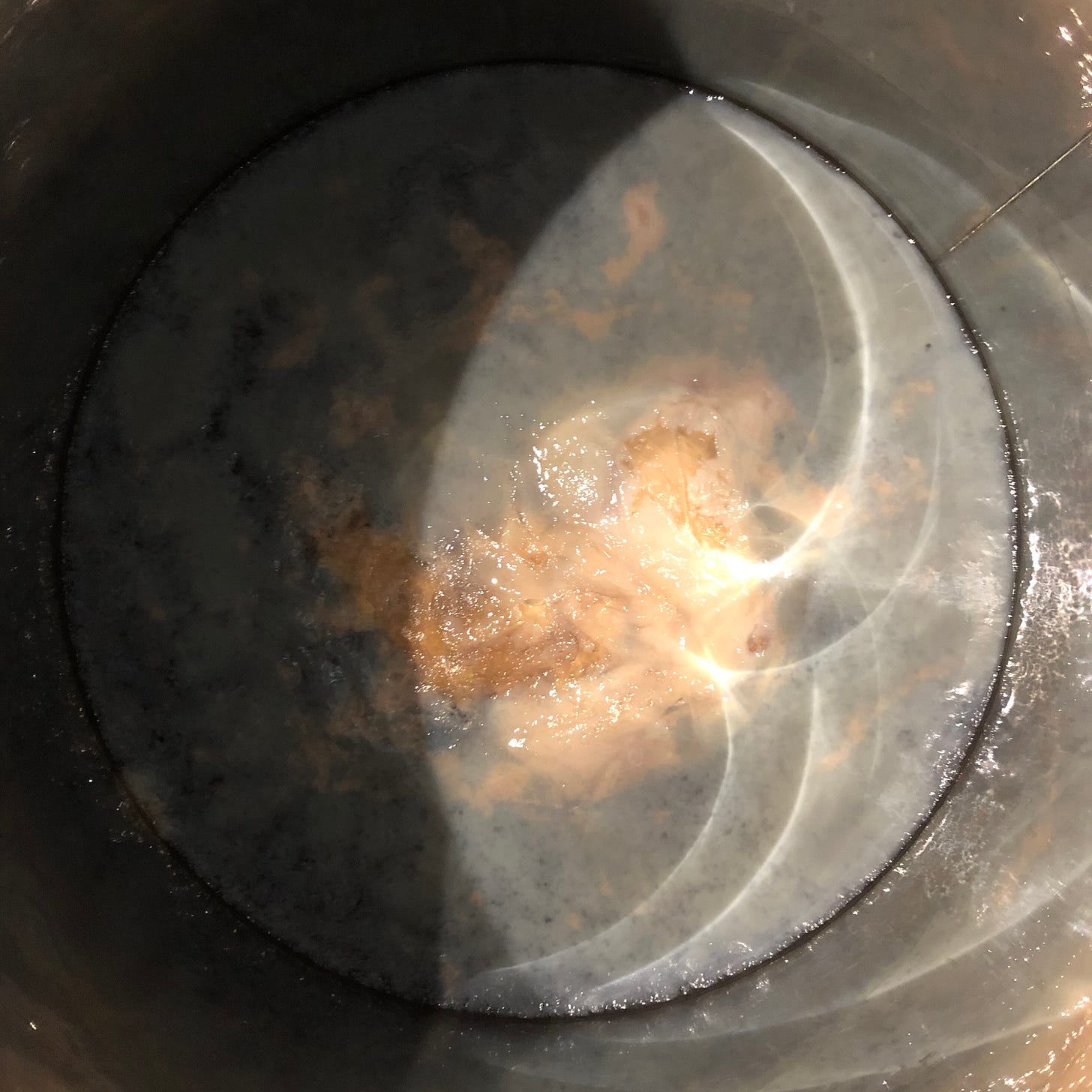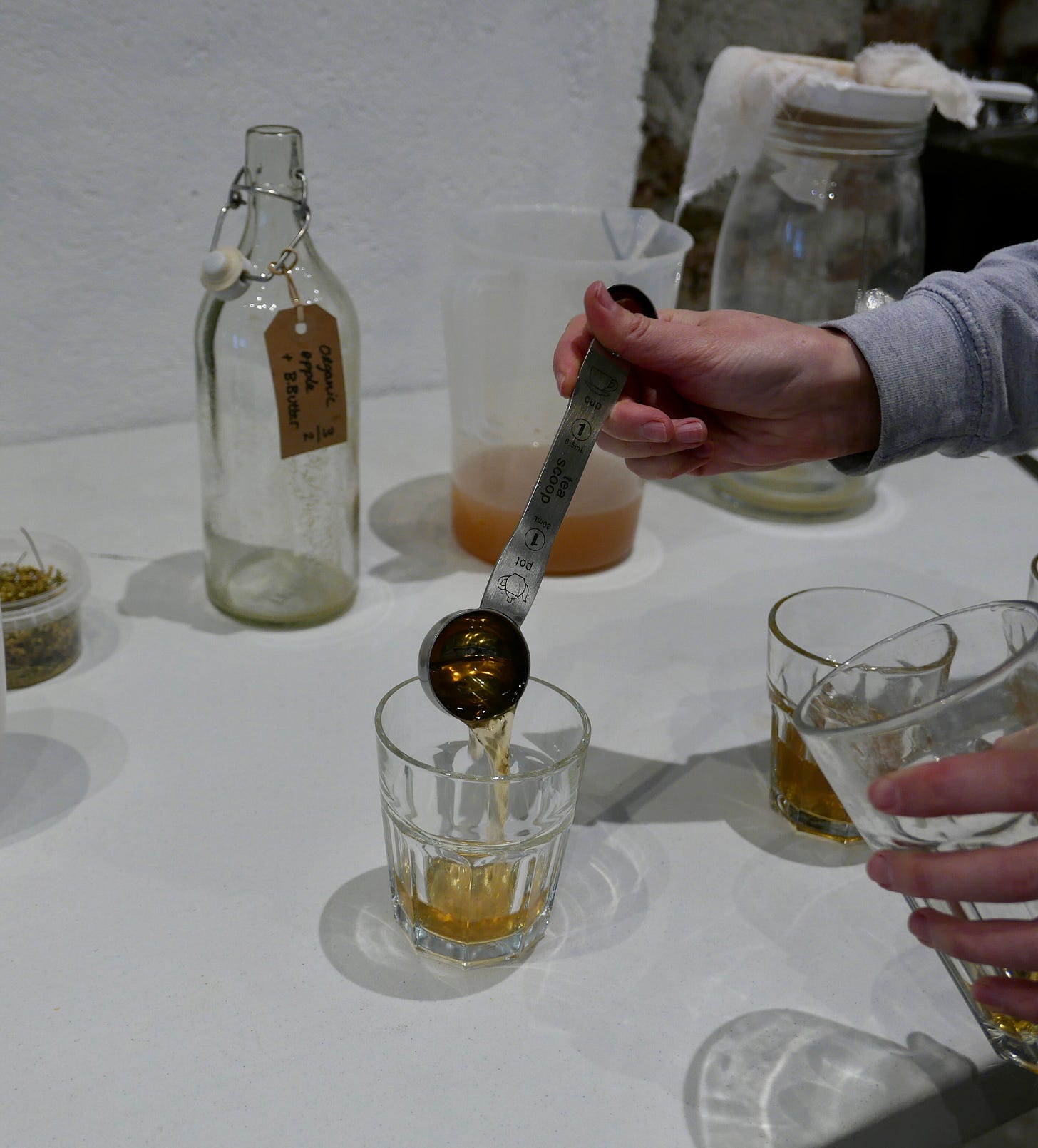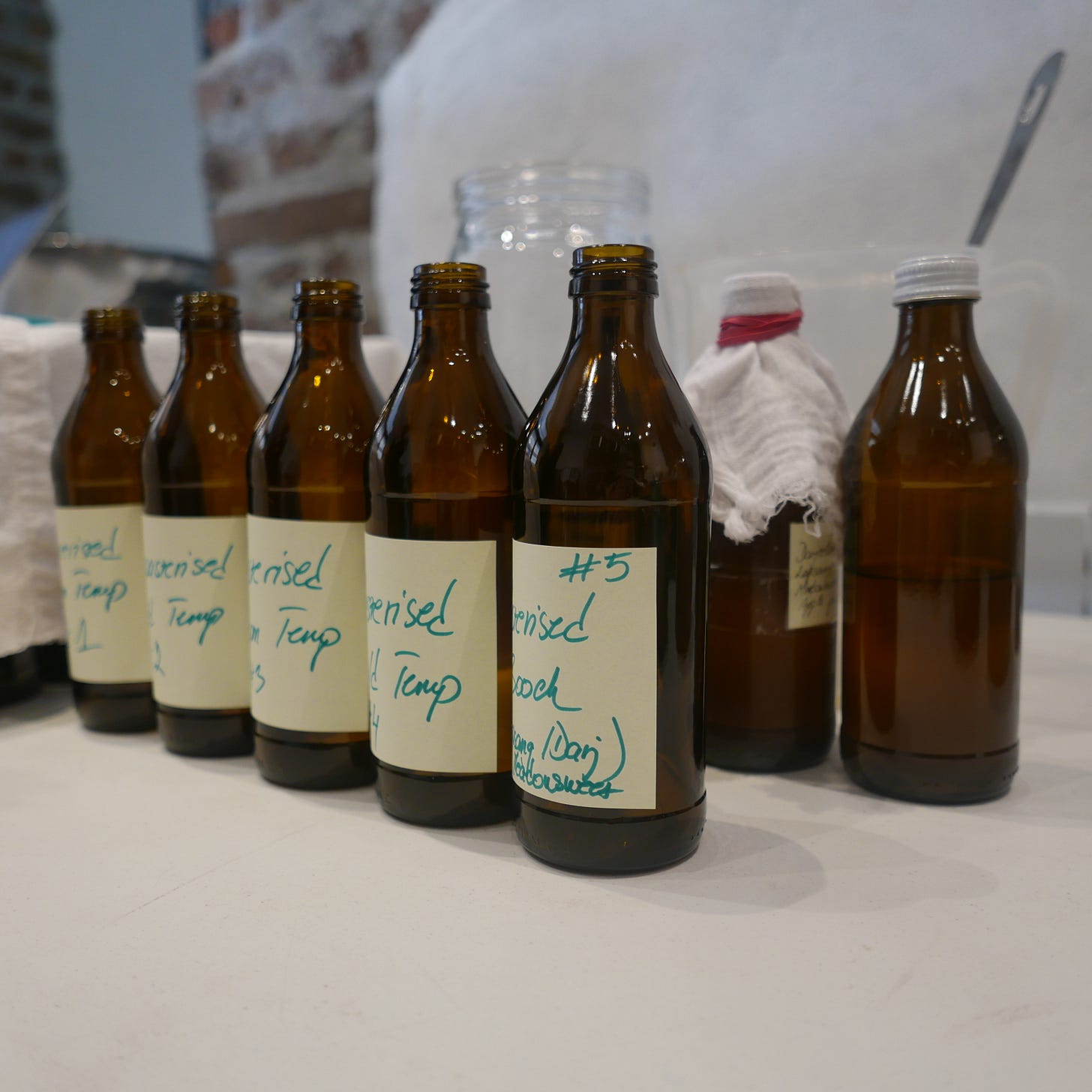Welcome to the Ómós Digest. This newsletter will hopefully bring you on that journey about the food you were looking for, or perhaps never knew existed. It is our quest to expand on what we don’t know and to share with those who care. If you haven’t read Newsletter #1 yet, it can be found here.
This newsletter is brought to you by Cúán Greene, Founder of Ómós.
My first memory of kombucha goes right back to when I was about 7 years old. And although you might expect to read the unlikely story of a child who once performed the dark arts of fermentation, it doesn’t happen.
Growing up in the ‘90s in Dublin, from what I remember, there was very little emphasis on where food came from. Farmers markets were few and far between, and those searching for organic produce had to leave the city or shop at health food shops of the past (whose odour I can only describe as a bazaar of stale spices crossed with a pet shop). I recall however that our neighbours were very much ahead of their time. Their son Finn was my age and we spent every minute together as children. While my favourite lunch under the age of 10 may have been Campbell’s chicken soup mixed with Koka curry noodles (don’t knock it until you try it), what was found across the road was wholemeal bread, live yoghurt, tofu, organic meat and whole nut butter. They practiced yoga long before any of us really had any concept of what it was, and drank kombucha before we knew anything about the ‘health halo’ that surrounds it today. I recall seeing Finn’s parents drinking this brown liquid, often with a slice of rye toast spread with Marmite.
Their kombucha lived in the fridge door, next to glass milk bottles sealed with a red foil lid, which once upon a time were delivered daily by the milkman. One day, after months of yearning to taste the kombucha, I found myself alone in the kitchen. After a quick look around to see no one was watching, I opened the fridge door and proceeded to take a swig. Upon swallowing the liquid I realised my mistake, racing to the sink for a gulp of water and to dispose of the unfamiliar flavour and texture. I must have swallowed the SCOBY. At that moment I identified kombucha as an adult beverage I would never enjoy (ahem) and replaced what I had drunk from the bottle with water so nobody would notice the missing contents.
Fast forward 21 years and here I am launching a kombucha-based beverage for those who care for a drink other than alcohol. While I love a tipple, I sometimes pine for something other than alcohol as it just sits better. Only last week before the poor weather reappeared, (here in Ireland, it seems we are rewarded with a second winter) I found myself indulging in a midweek bottle of wine a couple of hours earlier than expected. It was the picture of a beautiful spring evening. I was enjoying the prolonged stretch and by 7.30 pm, my bottle had been well and truly consumed. I was faced with a conundrum I am sure you can relate all too well to: opening a second bottle, making a splash and sacrificing the following morning, or putting on my responsibility cap and retiring inside in preparation for an anticlimactic demise to the evening. If there was a bottle of something tasty that had the sophistication of wine, without the high ABV, I would have been delighted!
Going nolo with kombucha
Kombucha is traditionally sugar-sweetened tea, fermented with live microorganisms. It naturally produces ethanol, which is generally maintained beneath a level of 0.5%, meaning it can be regarded as alcohol-free. Let it be noted that a very very ripe banana contains about 0.4% ABV so we’re safe here, unless you’ve heard about a fella who got drunk on a banana.
Kombucha uses tea, sugar, and water with the addition of a little kombucha from a previous batch (known as back slopping or starter liquid) and a SCOBY (short for Symbiotic Culture of Bacteria and Yeast) also known as the mother. While kombucha carries benefits for our gut microbiome and is said to contain high amounts of probiotics, what draws me to kombucha is its flavour. The mother feeds on the sugar present in the liquid, decreasing the pH and thus, creating acidity. It is this balance of sweetness and acidity together with the tannins and individual flavours from the tea that makes the beverage so delicious.
Within the development of the Vintner’s Companion, we implemented a technique known as fat washing. It is not well documented but was established in one of the world’s most iconic restaurants WD-50 based in New York, by Wylie Dufresne and his team. At its source, fat washing involves the distribution of fat with alcohol, allowing the alcohol to take on the flavour of the selected fat. Rather than leaving you with the undesirable viscosity of melted Hershey’s, what is attained is a liquid that carries more weight and enriched flavour. In our circumstance, we were looking to give our beverage the weight and mouthfeel of alcohol without using alcohol as a base. Through a number of tests, we determined that by adding brown butter (butter whose milk solids have been caramelised in a pan, giving it a rich, nutty flavour and aroma) to apple juice, allowing it to macerate, and then straining it, produced liquid that has the weight and mouthfeel of a well-made wine, with the caramelised, nutty flavours of a Tarte Tatin.
Whole leaf vs tea bags
Those of you who know Harry Colley, will of course know of his nut butter, Harry’s Nut Butter. A glutton like myself, Harry is partial to the finer things, but is also very familiar with foods of lesser pedigree, such as his mid-week snack; a microwaved frankfurter rolled up in a slice of supermarket sliced bread and doused in Ketchup, all washed down with Irish breakfast tea. In a recent catch-up, we spoke about the artistry of the tea ceremony, and why today are we being led to believe that the teabag, something that has been with us through thick and thin, produces mediocre tea? Quashing the tea bag, almost feels as if we are stamping on our cultural identity.
That being said, what I would recommend when making kombucha is starting off with quality tea. The better the tea you have selected, the better your kombucha will be. Of course, teabags will work but you won’t get the same results as if you use whole leaf tea. Whole leaf or loose leaf tea refers to tea with the leaves fully intact. Place the leaves in a clear pot, pour over your water and watch the whole leaves unfurl, releasing their aromatic bouquet. I have this tea server by Kinto Japan I adore. It makes two generous cups and I love watching the dance between water and tea as they infuse and unite. Teabags are most often made up of the opposite: low-grade tea leaves consisting of dust and fannings, with tiny particles amounting to high surface areas. The surface area results in a loss of essential oils which is inevitably detrimental when brewing tea, and in our case, results in kombucha that lacks clarity. Teabags are often mass-produced and developed using blends of teas that can stand up to milk and sugar. While strong high caffeinated teabags may be wonderful for a cuppa, they don’t fare too well when you are trying to create a uniquely flavoured kombucha. Using whole leaves reduces the surface area, allowing for a slower release of flavour and caffeine. This enables you to better manage your brew time, reduce astringency and put more focus on the unique flavour of your tea.
The following recipe is an adaptation from one of the blends we used to make the Vintner’s Companion. It uses Darjeeling tea, a light, aromatic tea from Darjeeling in West Bengal in India (a region known for tea production like Champagne is to France). We use an organic Darjeeling from the Highlands estate in Bengal. The tea is a blend of first and second flush tea, meaning the earliest buds and the secondary flourish of leaves to appear in the season, which is generally seen as the purest. Darjeeling has three major flushes with varying characteristics.
After the SCOBY has done its work, we separate it from the liquid and add the meadowsweet - a herb that flowers in mid-May in Ireland and is found along river banks and other areas with freshwater. It has a subtle flavour reminiscent of almond, hay and vanilla and is best added post-fermentation. You will better retain the flavour this way. You can pick the flowers from meadowsweet when in season and dry them for later use all year round. Remember not to pick all of the flowers though, as the bees need some too.
DARJEELING AND MEADOWSWEET KOMBUCHA
900 ml filtered water
3.5 g loose Darjeeling tea leaves
50 g organic cane sugar
10 g dried meadowsweet (pick it in May or purchase it dried here)
Kombucha SCOBY (this is best gotten from a friend who currently makes kombucha. You can also buy a SCOBY online)
Method:
Begin by sanitising all of your equipment. Ensure everything is very clean. You can find instructions for sterilising at the bottom of newsletter #1.
Place your tea and sugar in a large heatproof container or pot.
Heat half the water and pour over your tea and sugar.
Allow to steep for 1 hour.
Strain and top up with the remaining 450ml of water. Ensure that the tea is completely cool before you proceed.
Add the kombucha to your sweet tea.
Add the SCOBY using very clean hands. Gloves are preferred.
Moisten the top of the SCOBY with a little of the mixture to avoid dryness and cover with a very clean kitchen towel and elastic band. Do not cover with a lid.
Leave for 5-10 days, tasting for acidity. Your kombucha won’t have a fizz at this stage.
Remove the SCOBY along with 100 ml of kombucha and reserve it in tupperware in the fridge. You can use it again for your next brew.
When the kombucha is to your liking, add the meadowsweet and allow it to steep overnight.
The following day, strain the kombucha and place it in a clean container or sterilised bottles capable of holding some pressure.
For a lightly carbonated kombucha, place the bottles in the fridge. This is now ready to drink. Alternatively, for sparkling kombucha, leave the bottles outside for 1-3 days before placing them in the fridge. A secondary fermentation appears in the bottles causing CO2 to be created, giving you that sparkle.
Kombucha isn’t just for drinking, it brings great acidity when reduced. Here is a great glaze to brush over pastries and give them a sheen.
DARJEELING AND APPLE KOMBUCHA GLAZE
2 L Darjeeling kombucha (recipe above)
2 L organic apple juice (we use Clashganny Farm Jonagold apple juice)
300 g caster sugar
Method:
Place all of the ingredients in a pot and whisk to combine.
Bring the liquid to a boil and reduce to a simmer.
Scum will rise to the top, so skim with a ladle as necessary.
Reduce the liquid until you acquire a syrup. When cooled, the syrup will always be thicker than when warm.
Brush the room temperature syrup over your pastries for the perfect sheen. I personally brush them twice to ensure a nice layer.
We are in the process of brewing our #2 batch of Vintner’s Companion. Thank you so much for all the lovely feedback. It seems you enjoyed our little tipple! We’ll let you know first when the next batch is available.
As always, thank you for reading the Ómós Digest. This is newsletter #6, so if you missed our previous editions, you’ve got plenty to catch up on, including our Something Saucy offering. You can also check out omos.co if you’re curious about our story.











You had me at sugar sweetened tea.. you know what to bring next time you visit it the poor relatives in Conamara.....x